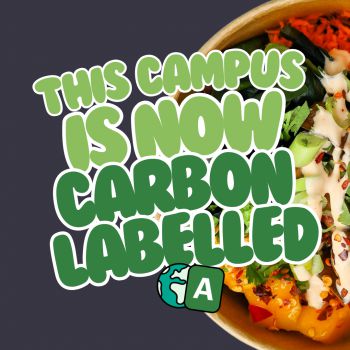Carbon labelling on campus menus: how Foodsteps calculates carbon in different foods
By: Maria Andreou
Last updated: Monday, 21 October 2024


You may have noticed something different on the menus of the Sussex Uni Food eateries on campus.
Want to know more about how our catering partners calculate the carbon in their menu items?
Foodsteps
Sussex Uni Food has teamed up with Foodsteps, a UK food sustainability company committed to developing methods for assessing and minimising the environmental impact of food.
As Sandra Juan Delgado, Sustainability Manager for Sussex Uni Food, explains in her article, the aim of carbon labelling is to spearhead an innovative approach to better understand the carbon footprint of the meals offered on campus.
Foodsteps helps consumers make sustainable choices and supports food businesses in reducing their environmental footprint. Carbon labelling provides clear information about the environmental impact of food, enabling informed decisions that can help to reduce carbon emissions.
The traffic light system guides consumers to consider the environmental impact of their food choices and explore new, sustainable options.
Carbon ratings were first introduced to the ACCA café menu earlier this year and can now be found in all Sussex Uni Food outlets on campus.
Carbon ratings explained
You’ll see ratings ranging from A to E alongside items on various campus menus, each accompanied by a traffic light colour system for easy identification. An 'A' rating indicates a "very low" carbon rating, while an 'E' indicates a "very high" carbon intensity.
The labels display the carbon footprint per kilogram of each item, which refers to the greenhouse gas emissions released from farm to waste. This system considers emissions from processing, packaging, transport, and waste disposal.
The ratings are based on a global carbon budget for food, which was established by the EAT-Lancet Commission to help achieve healthy diets and sustainable food production, helping individuals reduce their overall carbon footprint.
The daily carbon intensity allowance is 2.45 kg CO2e per person, which is significantly lower than the current daily average global diet of 6.13 kg CO2e per person.
How Foodsteps deploys the data
Foodsteps calculates the carbon footprint values in a variety of ways to assess the environmental impact, and estimate the origins of, different food items. It draws on publicly available data and information from academia, industry and research bodies.
This includes direct calculations utilising leading Life Cycle Assessment (LCA) data tailored to the particular food item or recipe, indirect calculations employing similar food items when a direct match is unavailable, and amalgamations of multiple studies for processed items with numerous ingredients.
Beyond your carbon ‘foodprint’
Foodsteps’ rating system provides a standardised way to compare products based on their carbon emissions. By understanding the full lifecycle of different menu items, we can implement measures to reduce our carbon footprint, enhancing our role in protecting the planet.
It's important to note that while carbon footprint scores are a significant aspect of food sustainability, they don't capture the whole picture. Other factors, such as land and water use, fair pay, and food security, are equally important.
Have you spotted carbon labels in any Sussex Uni Food menus on campus yet?
Find out more
Stay informed about initiatives like this, which contribute to our goal of becoming one of the most sustainable universities globally and find out more about Foodsteps and their methodology by reading their FAQs.
For questions or feedback, please contact TransformingSussex@sussex.ac.uk.
